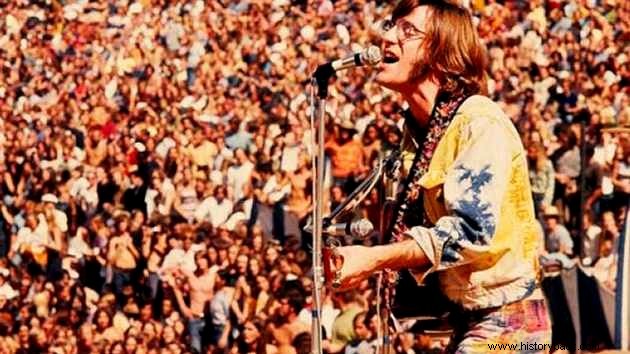The hippie movement appeared in the city of San Francisco, on the west coast of the United States, in the 60's.
The hippies preached free love, respect for nature, pacifism and a simpler life, without consumerist concerns.
They also used drugs to open their minds and be more creative.
Origin of the Hippie Movement

With the escalation of violence between the United States and the Soviet Union, during the Cold War, a movement that contests violence and capitalism emerged:the beat .
Beat culture questioned traditional American and Western values such as morality, marriage, beauty standards and a consumerist lifestyle.
Its origins date back to a group of writers who came together in the 1950s with the aim of creating literary works and criticizing American society.
The main names were Jack Kerouac, Allen Ginsberg, William Burroughs, Anne Waldman, Elise Cowen, among others.
See also:Cold War:features, causes and consequencesCharacteristics of Hippie Culture
The hippie movement was heir to the beat culture American, but they went beyond a literary school and created a way of life of their own.
It didn't take long for young Americans, disillusioned by what was happening in the Vietnam War, to feel attracted to the speech of “peace and love” and “make love, not war”
For this reason, the hippie movement fits into the counterculture strand, as it disagrees with the dominant culture. They still believed that the consumption of hallucinogenic drugs opened the mind to new creative possibilities.
Hippies protested against the war by participating in marches and were also involved in feminist and civil rights movements for Afro-descendants, along the lines proposed by Martin Luther King.
With their defense of sexual freedom, they also helped to discuss issues related to homosexuality.
They dressed in an opposite way to the current fashion with baggy pants and blouses, floral print items, long hair bands and the use of large beards for men.
Through the consumption of hallucinogenic drugs, they developed a psychedelic culture that is characterized by the use of strong colors, marked features and references to nature, especially flowers.
Unfortunately, the abuse of these toxic substances has led many artists to premature death.
See also:CountercultureWoodstock Festival

The great milestone of the hippie movement was the music festival held in Woodstock, New York, in August 1969.
Artists such as Jimi Hendrix, Joan Baez, Carlos Santana, Janis Joplin, The Who, Grateful Dead, and many others have performed.
The festival became a symbol of that time by bringing together, for three days, people who believed in a society different from the one proposed by the stats quo .
End of the Hippie Movement
In the 70's, several ideas defended by hippies were absorbed by society.
Likewise, some of its main representatives such as Jimi Hendrix, Jim Morrison and Janis Joplin died of overdose. John Lennon, who flirted with hippie thinking in the 1970s, was murdered in 1980.
Also the fact that the Manson family, an established hippie community in California, committed several murders and robberies, contributed to discredit part of this movement.
However, hippie ideals are still present through the ecology movement, the non-consumer, vegetarian or vegan, and even minority rights campaigns.
Hippie Movement in Brazil

The hippie movement in Brazil coincides with the period of the military dictatorship.
This makes the movement a target of the military and heavily criticized by society as a whole. Its most visible face is the tropicalismo that mixes several hippie principles, but reinterpreted them for the Brazilian reality.
Thus, we have names like Gilberto Gil and Caetano Veloso claiming a new way of making music and lyrics full of symbology.
Likewise, we have the musician Raul Seixas mixing rock with northeastern rhythms. His lyrics composed with the writer Paulo Coelho spoke of other eras, spaceships and criticized the capitalist world.
In Brazil, there were some hippie communities where collectivity, the common good, free love and drug consumption were preached.
Also read about this topic:
- 60's
- 70's
- Feminism
- Urban Tribes
